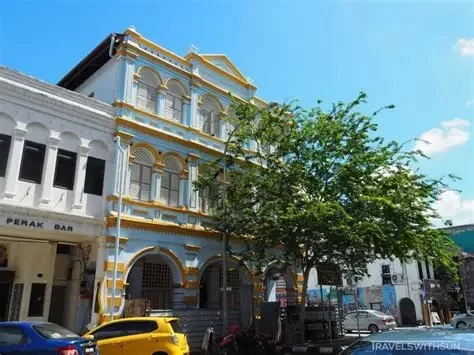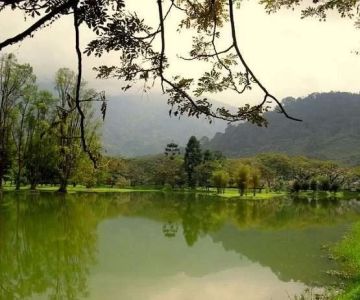
- ipoh-old-town-tracing-the-citys-colonial-footprint
- kellies-castle-an-eerie-monument-of-unfinished-dreams
- birch-memorial-clock-tower-and-the-controversies-it-holds
- han-chin-pet-soo-a-secret-glimpse-into-ipohs-tin-legacy
- concubine-lane-from-hidden-past-to-tourist-hotspot
- railway-station-and-town-hall-ipohs-iconic-white-structures
1. Ipoh Old Town: Tracing the City’s Colonial Footprint
Ipoh Old Town is the perfect starting point for anyone seeking to immerse themselves in the historic roots of this Malaysian city. Once a bustling hub during the tin mining boom of the late 19th century, today it stands as a living museum of British colonial charm and local culture. Strolling through Old Town’s narrow lanes reveals mural-lined walls, aging shophouses with louvered windows, and aromatic whiffs of white coffee wafting from traditional kopitiams.
A notable building is the Hong Kong and Shanghai Bank building, constructed in 1931 and still used as a financial institution. Its neoclassical columns and concrete frieze stand as a testament to Ipoh's British architectural influence. Visitors often share that walking around Old Town feels like stepping into a time capsule, with every creaking wooden shutter or faded tiled storefront whispering stories of a bygone era. For travelers keen on self-guided heritage walks, Ipoh Old Town offers one of the most atmospheric journeys in all of Malaysia.
2. Kellie’s Castle: An Eerie Monument of Unfinished Dreams
Located just 30 minutes from central Ipoh, Kellie’s Castle is one of the most mysterious and romantic historical landmarks in Malaysia. Built by Scottish planter William Kellie Smith in the early 1900s, the castle was intended as a luxurious mansion for his family. However, construction was halted abruptly when Kellie died of pneumonia during a trip to Lisbon, and the castle was never completed.
Touring Kellie’s Castle, visitors can walk through rooms that were supposed to house a rooftop tennis court, a wine cellar, and Malaysia’s first elevator shaft. The eerie ambiance has made it a favorite spot for ghost hunters and history buffs alike. Locals often speak of unexplained shadows or strange whispers in its darkened halls. Whether or not the castle is haunted, it remains a powerful symbol of colonial ambition and personal tragedy.
For those planning a visit, bring a good pair of walking shoes and a camera—sunlight streaming through the castle’s stone arches creates a hauntingly beautiful scene worth capturing.
3. Birch Memorial Clock Tower and the Controversies It Holds
At the heart of Ipoh’s historic district stands the Birch Memorial Clock Tower, built in 1909 to commemorate British Resident James W.W. Birch. While the structure is architecturally elegant—featuring four panels depicting civilizations and figures like Confucius and Shakespeare—it also carries deep historical tension.
Birch was assassinated in 1875 by local Malay warriors, who saw his administration as an affront to traditional governance. For some Malaysians, the clock tower represents colonial domination more than civic pride. In recent years, debates have emerged about the appropriateness of such monuments in a post-colonial society. Nonetheless, the tower remains an important part of Ipoh’s narrative, offering a lens into the complex intersection of power, resistance, and memory.
Local tour guides often incorporate this site into educational walking tours to spark conversation around Malaysia’s colonial past. It’s this juxtaposition—elegance and controversy—that makes Birch Memorial a must-visit for anyone trying to understand the full story of Ipoh.
4. Han Chin Pet Soo: A Secret Glimpse into Ipoh’s Tin Legacy
Tucked discreetly on Jalan Bijeh Timah, Han Chin Pet Soo is the refurbished home of Ipoh’s exclusive Hakka miners’ club, originally founded in 1893. Entry is free, but visitors must book in advance due to its limited daily capacity. This museum vividly details the city’s tin mining roots, intertwined with gambling dens, secret societies, and opium-smoking traditions.
Many travelers come away astonished at the depth and honesty of the exhibits. Where else can you find wax figures of 1930s gangsters or see original gambling tables once used by club members? Volunteers who run the museum often share personal family connections to the mining industry, bringing a deeply human perspective to the polished displays.
For history lovers and photographers, Han Chin Pet Soo offers not only insight but rare authenticity. We recommend adding this stop to your Ipoh itinerary if you want to peel back the shiny tourism layer and explore the city’s gritty, fascinating underworld past.
5. Concubine Lane: From Hidden Past to Tourist Hotspot
Concubine Lane, known locally as “Lorong Panglima,” has one of the most colorful histories in Ipoh. Once a secret residential alley for wealthy Chinese tin tycoons’ mistresses during the early 20th century, the lane has transformed into a buzzing tourist destination full of artisanal shops, quirky cafes, and vibrant street art.
Many of the original structures still stand, with weathered walls and antique window shutters preserving their age. Visitors can taste local snacks like kaya puffs or grab handcrafted souvenirs while imagining the hidden dramas that played out behind closed doors. Weekend visits are especially lively, though those looking for a more peaceful, nostalgic experience should go during weekday mornings.
Concubine Lane’s evolution is a story of urban revival that highlights how heritage can be preserved and reimagined. Locals and returning Malaysians alike often share stories of how their grandparents once lived or worked in this area—giving the place an emotionally resonant charm.
6. Railway Station and Town Hall: Ipoh’s Iconic White Structures
No historic guide to Ipoh is complete without highlighting the majestic Ipoh Railway Station, fondly referred to as the “Taj Mahal of Ipoh.” Completed in 1917, the station’s whitewashed façade, Mughal-inspired domes, and manicured gardens make it a standout architectural gem. Right next door, the Ipoh Town Hall—also built during British rule—reflects neoclassical grace and municipal pride.
Both buildings are not only symbols of colonial engineering but are still in use today. The railway station remains an active hub, linking Ipoh with Kuala Lumpur and beyond. It’s a favorite photography spot for newlyweds and travelers alike, and it’s also where many begin their journey into the city’s history.
When visiting, make sure to spend time inside the station’s grand hall. From marble floors to antique benches, every element evokes the elegance of early 20th-century travel. Combined, these structures are more than photo ops—they’re living monuments to the blend of British vision and Malaysian endurance.
For the most convenient travel advice, guided tours, and curated cultural experiences, consider visiting UAK Travel. They offer personalized recommendations to help you make the most of your historical exploration in Ipoh and beyond.







 Lata Mentagan Waterfall3.0 (4 reviews)
Lata Mentagan Waterfall3.0 (4 reviews) My Wellness Diary Nutrition Centre5.0 (1 reviews)
My Wellness Diary Nutrition Centre5.0 (1 reviews) Triple A Satay BSC4.0 (3 reviews)
Triple A Satay BSC4.0 (3 reviews) Surau Al-Ameen4.0 (7 reviews)
Surau Al-Ameen4.0 (7 reviews) Setia City Mall New Wing4.0 (165 reviews)
Setia City Mall New Wing4.0 (165 reviews) Azuratailor & AzuGarden Sungai Koyan4.0 (4 reviews)
Azuratailor & AzuGarden Sungai Koyan4.0 (4 reviews) Exploring the Unique Designs of Mosques in Malaysia: A Journey Through Islamic Architecture
Exploring the Unique Designs of Mosques in Malaysia: A Journey Through Islamic Architecture Exploring the Architectural Beauty of Mosques in Malaysia: A Journey Through Islamic Architecture
Exploring the Architectural Beauty of Mosques in Malaysia: A Journey Through Islamic Architecture Visiting Malaysia’s Most Famous Mosques During Eid: A Unique Cultural Experience
Visiting Malaysia’s Most Famous Mosques During Eid: A Unique Cultural Experience How to Get to the Famous Mosques in Kuala Lumpur by Public Transport: A Complete Travel Guide
How to Get to the Famous Mosques in Kuala Lumpur by Public Transport: A Complete Travel Guide Discover the History of Masjid Titiwangsa in Kuala Lumpur: A Cultural and Architectural Gem
Discover the History of Masjid Titiwangsa in Kuala Lumpur: A Cultural and Architectural Gem Top Mosques to Visit During Ramadan in Malaysia: A Traveler's Guide
Top Mosques to Visit During Ramadan in Malaysia: A Traveler's Guide